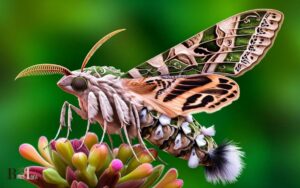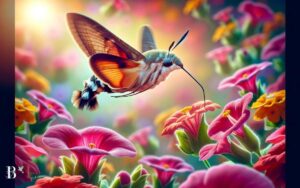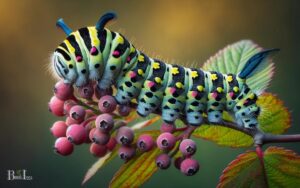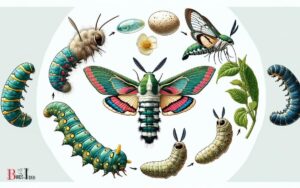When Do Hummingbird Moths Come Out: Find Out!
Hummingbird moths typically emerge and are most visibly active from late spring to early fall, peaking in numbers during the summer months. Their activity is particularly noticeable during the late afternoon and early evening hours.
Hummingbird moths, or hawk moths, display a behavior similar to hummingbirds, hovering and feeding on nectar.
They are a delight to observe and can be seen:
Observe the enchanting flight of hummingbird moths during warm summer evenings as they flit from flower to flower.

Key Takeaway
Hummingbird Moth Seasonal Activity Guide
| Region | Active Period | Time of Day | Preferred Habitat |
|---|---|---|---|
| North America | Late Spring to Fall | Late Afternoon | Gardens with Tubular Flowers |
| Europe | Early Summer to Fall | Early Evening | Flowering Meadows and Woodlands |
| Worldwide | Varies by Species | Dusk (Variable) | Areas with Ample Nectar Sources |
Identifying Hummingbird Moths
Hummingbird moths can be identified by their rapid wing movements and their ability to hover near flowers while feeding.
These moths, often mistaken for tiny hummingbirds, have long, narrow wings and a streamlined body.
Their coloring is typically a combination of brown, gray, and white, with some species featuring hints of orange or pink.
One distinguishing feature is their long proboscis, which they use to drink nectar from flowers.
Their hovering behavior is similar to that of hummingbirds, and they emit a soft humming sound as they move from flower to flower.
Observing these characteristics can help differentiate them from other types of moths or insects.
Understanding these key identifiers can aid in recognizing and appreciating these fascinating creatures in the wild.
Factors Influencing Hummingbird Moth Activity:
Temperature:
- Warmer temperatures generally increase hummingbird moth activity.
- Cold temperatures can limit their flight and feeding capabilities.
Light Conditions:
- Hummingbird moths are diurnal, with peak activity during daylight.
- They are attracted to bright flowers and may be less active in low light.
Floral Availability:
- The presence of nectar-rich flowers influences their foraging behavior.
- Abundance and variety of flowers impact their overall activity.
Seasonal Changes:
- Activity may vary seasonally, with increased presence during warmer months.
- Migration patterns and availability of host plants play a role.
Wind Speed:
- High winds can impede their flight and feeding activities.
- Calm conditions are more conducive to hummingbird moth activity.
Habitat and Range
Hummingbird moths are found in a variety of habitats across North and South America, including gardens, meadows, and woodland edges.
Their range extends from Canada to Mexico and as far south as Argentina, with different species occupying specific regions.
These moths prefer warm, sunny environments with abundant nectar sources, making them common visitors to flowering plants.
Geographic Distribution and Habitats
The hummingbird moth can be found in various habitats across North and South America, including gardens, meadows, and woodland edges.
This adaptable insect thrives in diverse environments, making it a common sight in many regions.
Here are some key points about the geographic distribution and habitats of hummingbird moths:
- Wide Range: Hummingbird moths have a broad geographic distribution, ranging from Canada down to Argentina, covering a large portion of the Americas.
- Urban Areas: They’re also known to frequent urban areas, such as parks and residential gardens, where they can find suitable nectar sources.
- Preference for Flowers: Hummingbird moths are often found near flowering plants, as they rely on the nectar for sustenance.
- Woodland Edges: These insects are particularly fond of woodland edges, where they can find a mix of open space and vegetation for foraging and shelter.
Ideal Living Conditions
The hummingbird moth thrives in a range of environments and habitats characterized by abundant floral resources and sunny, open spaces.
These ideal living conditions provide the necessary sustenance and environment for the hummingbird moth to flourish.
Here are some key factors that contribute to the ideal living conditions for hummingbird moths:
- Abundant Floral Resources: Hummingbird moths are often found in areas with a variety of nectar-producing flowers, which serve as their primary food source.
- Sunny and Open Spaces: These moths prefer habitats with ample sunlight and open areas, as they’re more active in warm and sunny conditions.
- Diverse Vegetation: Habitats with a diverse range of plants and flowers provide a continuous supply of nectar throughout the moth’s active period.
- Sheltered Resting Spots: Hummingbird moths seek out sheltered spots for resting during the day, such as dense foliage or low vegetation.
These factors contribute to the hummingbird moth’s thriving in its preferred environments.
Now, let’s delve into their intriguing life cycle and behavior.
Life Cycle and Behavior
Hummingbird moths have fascinating mating and reproduction habits. They also have interesting seasonal activity and habits. Additionally, they have unique feeding and migration patterns.
Understanding their life cycle and behavior provides insight into their remarkable adaptability and survival strategies.
Mating and Reproduction Habits
During their mating and reproduction cycle, hummingbird moths typically exhibit distinctive behaviors and life cycle stages.
- Courtship: Male hummingbird moths perform intricate flight displays to attract females, showcasing their agility and speed.
- Mating: Once a female is enticed, mating occurs, often lasting for several hours as the male transfers his sperm to the female’s reproductive system.
- Egg-laying: After mating, the female seeks out suitable host plants, where she carefully deposits her eggs, ensuring the survival of her offspring.
- Life cycle: The eggs hatch into larvae, which then go through several stages of development before emerging as adult moths. This complete metamorphosis process takes several weeks to months, depending on environmental conditions.
Understanding these behaviors and life cycle stages can provide insight into the fascinating reproductive habits of hummingbird moths.
Seasonal Activity and Habits
Seasonal activity and habits of hummingbird moths encompass their life cycle and behavior, including their feeding patterns and migratory tendencies.
Hummingbird moths, like other moths, go through a complete metamorphosis, progressing from egg to larva (caterpillar), pupa, and finally adult.
During the warmer months, they’re active and can be seen visiting flowers to feed on nectar, often at dawn and dusk.
Their migratory habits vary by species, with some undertaking long-distance migrations to escape harsh winters, while others may overwinter in warmer regions.
As temperatures cool, hummingbird moths enter a dormant state, either as pupae or adults, to survive the winter.
Understanding these seasonal patterns and behaviors can help enthusiasts anticipate and appreciate the presence of hummingbird moths in their local ecosystem.
Feeding and Migration Patterns
The moth’s feeding and migration patterns reflect its life cycle and behavior, demonstrating a reliance on nectar and a tendency for long-distance travel.
- Nectar Feeding: Hummingbird moths, like their namesake, primarily feed on the nectar of flowers using their long proboscis, which allows them to reach the nectar of deep-throated flowers.
- Nocturnal Feeding: They’re often active during dusk and dawn, utilizing their excellent low-light vision to feed during these times.
- Migration: Hummingbird moths exhibit a migratory behavior, especially in response to changing seasons and availability of food sources, often traveling long distances in search of suitable habitats and food.
- Overwintering: In colder regions, some species of hummingbird moths will overwinter as pupae or adults, emerging in the spring to continue their life cycle.
Climate and Seasonal Patterns
Hummingbird moths emerge when favorable climate conditions and seasonal patterns align. These moths are typically active during the warmer months, from late spring to early fall, when flowers are abundant and temperatures are conducive to their activity.
In regions with cold winters, they’re more likely to be seen during the summer months. Their emergence is also influenced by the availability of nectar-producing flowers, as they rely on these food sources for sustenance.
Additionally, favorable weather conditions, such as mild temperatures, light winds, and adequate humidity, play a role in their activity.
When these factors come together, hummingbird moths are more likely to be seen hovering around flowers, exhibiting their distinctive rapid wingbeats and feeding behavior.
What Is the Best Time to Spot Hummingbird Moths in Their Life Cycle?
The hummingbird clearwing moth cycle spans from late spring to early fall, making the best time to spot them during this period. Look for them in areas with abundant nectar-producing flowers, especially during the warmest parts of the day. These fascinating creatures are most active during the late afternoon and early evening.
Daily Activity and Feeding Habits
When favorable climate conditions and seasonal patterns align, hummingbird moths exhibit distinctive rapid wingbeats and feeding behavior, showcasing their daily activity and feeding habits.
- Diurnal Feeding: Hummingbird moths are diurnal creatures, meaning they’re most active during the day, particularly during the early morning and late afternoon.
- Nectar Feeding: They’ve a remarkable preference for nectar-bearing flowers, using their long proboscis to feed on a variety of flowering plants.
- Hover-Feeding: Hummingbird moths have the ability to hover in front of flowers while feeding, much like their namesake, hummingbirds.
- Rapid Flight: Their flight is characterized by rapid, erratic movements, allowing them to swiftly maneuver between flowers and evade predators.
With their diurnal nature and unique feeding habits, hummingbird moths play a vital role in pollination. This makes understanding their preferred plants and flowers crucial for attracting and supporting these fascinating creatures.
Conclusion
Hummingbird moths are fascinating creatures that can be found in various habitats and regions.
Their unique appearance and behavior make them a delight to observe, especially during the warm summer months.
By planting their favorite flowers and creating a welcoming environment, gardeners can attract these beautiful moths to their gardens, adding a touch of wonder and magic to their outdoor spaces.
Just like the elusive hummingbird, the hummingbird moth brings a sense of grace and beauty to the natural world.






